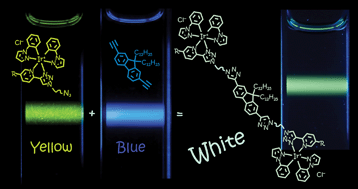Triazole–pyridineligands: a novel approach to chromophoric iridium arrays†
Abstract
We describe a novel modular approach to a series of luminescent iridium complexes bearing

* Corresponding authors
a
Institute for Molecules and Materials, Radboud University Nijmegen, Department of Molecular Materials, Heyendaalseweg 135, Nijmegen, The Netherlands
E-mail:
m.felici@science.ru.nl, a.rowan@science.ru.nl
Fax: +31 24 36 52929
Tel: +31 24 36 52323
b Van't Hoff Institute for Molecular Sciences, University of Amsterdam, P.O. Box 94157, Amsterdam, The Netherlands
We describe a novel modular approach to a series of luminescent iridium complexes bearing

 Please wait while we load your content...
Something went wrong. Try again?
Please wait while we load your content...
Something went wrong. Try again?
M. Juríček, M. Felici, P. Contreras-Carballada, J. Lauko, S. R. Bou, P. H. J. Kouwer, A. M. Brouwer and A. E. Rowan, J. Mater. Chem., 2011, 21, 2104 DOI: 10.1039/C0JM03117H
To request permission to reproduce material from this article, please go to the Copyright Clearance Center request page.
If you are an author contributing to an RSC publication, you do not need to request permission provided correct acknowledgement is given.
If you are the author of this article, you do not need to request permission to reproduce figures and diagrams provided correct acknowledgement is given. If you want to reproduce the whole article in a third-party publication (excluding your thesis/dissertation for which permission is not required) please go to the Copyright Clearance Center request page.
Read more about how to correctly acknowledge RSC content.
 Fetching data from CrossRef.
Fetching data from CrossRef.
This may take some time to load.
Loading related content
